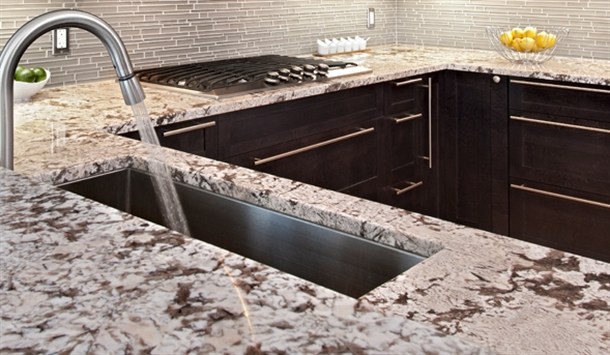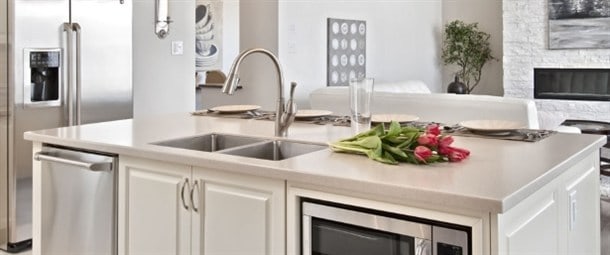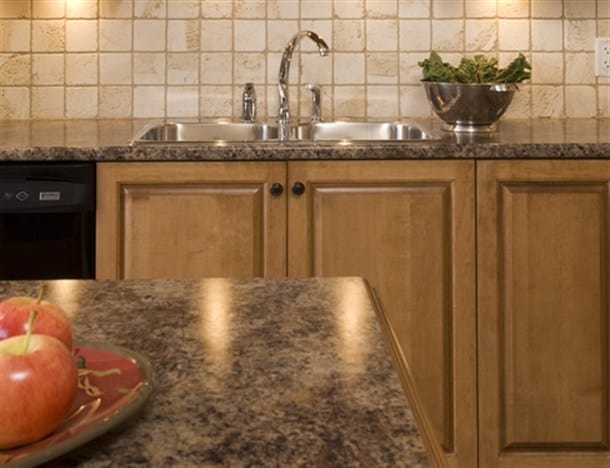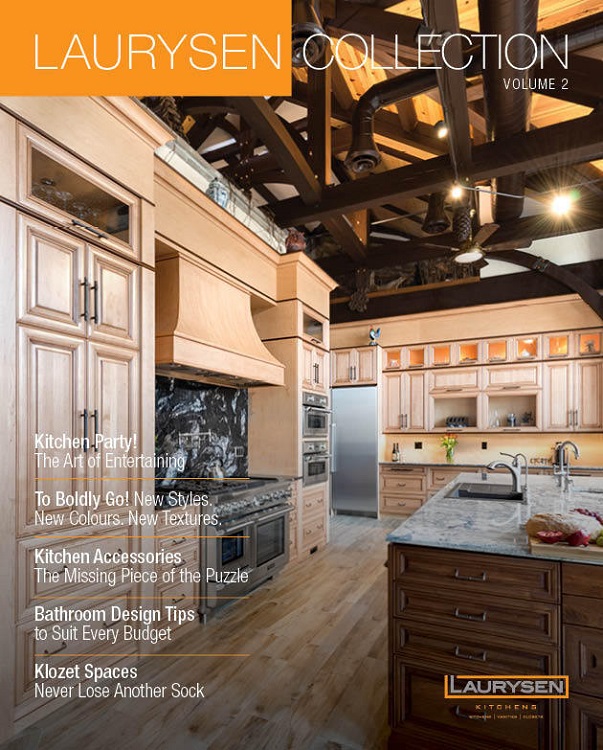Knowing how to take care of your countertops is important. It will help whether you’ve already got a countertop you love or you’re trying to learn what kind would be best for you. We look at granite, quartz and laminate.
Granite Countertops
Granite, as a natural stone, has an individuality to the patterns that brings the beauty of nature indoors. While incredibly hard and durable, it has some quirks you should be aware of.

The key thing with granite is that prevention is more important that with other types of countertop. Granite is porous (which means it absorbs), so many types need to be sealed at the factory before installation and then resealed about every 5 years. The sealer won’t prevent stains completely, but it will buy you some time to get the mess mopped up. Not all stones need to be sealed, so talk to your designer about the individual type of stone to be sure, as going by how shiny it is won’t help. The testing and sealing process isn’t hard to do yourself at home.
Granite is heat resistant, but there may be natural fissures in the stone that can expand in the heat and cause cracking. For this reason we recommend using trivets between your hot pots and your countertop.
Never chop directly on your granite – you won’t hurt the granite at all, but you’ll definitely dull your knives.
Cleaning Granite
For most everyday cleaning, a gentle liquid soap and warm water will do fine. Be sure that you don’t use anything abrasive, like ceramic cooktop cleaner, Comet, or pot scrubbing pads.
For spills that can stain, you may need to apply a paste mixture (called a poultice) and let it sit. The exact composition of the poultice will sometimes differ, depending on what you’re trying to get out. But for most stains, a mixture of hydrogen peroxide and diatomaceous earth will work. Apply it to the stain, seal it with plastic wrap and masking tape, and let it sit for a few days. Then remove the plastic, allow the poultice to dry, and pull it off. It should work but you may need to reapply.
For some specific types of stains you may need to use specific treatments. This couple used bleach to save their countertop from a serious blueberry stain.
Engineered Quartz Countertops
Quartz offers an incredible variety of surface patterns and textures, and they are heavier and more durable than laminate. They’ve got the best advantages of laminate and stone, even though the patterns will be more regular than with natural granite.

Because they’re manufactured from quartz particles and resin, quartz countertops are non-porous and won’t absorb staining liquids easily. They’re also an excellent choice for people who are conscious about hygiene and concerned about bacteria.
Another great thing about quartz is that they’re more heat resistant than any other countertop, but most manufacturers will still recommend not allowing hot pots to sit directly on the countertop. Even quartz has its limits.
As a resin-based product, there are some chemicals like nail polish remover, oven cleaners and fully concentrated bleach that can dissolve or stain quartz, so it’s important to be careful. Permanent markets can also stain. If you’re purchasing a quartz countertop it’s best to get the care sheet for your specific brand.
Cleaning Quartz Countertops
While quartz is highly resistant to staining, it’s best to wipe up spills right away so they don’t sit. For most situations, warm water and a gentle liquid soap will do. Avoid using abrasive cleaners that can scratch.
Laminate Countertops
Laminate is a really popular choice because it’s budget-friendly and very durable in some ways. There’s an almost infinite variety of textures, finishes and patterns available.

Laminate is very stain resistant, but is is vulnerable to heat and scratches. Always use a cutting board for food preparation because laminate will usually scratch. Trivets are also your friend when it comes to preventing damage from hot pots.
The key thing with laminate is not to let water or other liquids get near the seams around sinks or at the joins. While the surface of laminate can handle water the MDF core cannot. Also water can dissolve the glue between the surface and the core.
Cleaning Laminate Countertops
For most spills a simple damp cloth will do. It’s critical not to use abrasives like Comet or scouring pads. If a stain has formed, try a damp baking soda poultice first. Depending on the type of laminate, bleach or nail polish remover MAY be an option – but be sure you know if the manufacturer recommends it first, as they are bad for some kinds.
The Rewards of Proper Care
By remembering these tips and putting in a little time, your countertops will stay beautiful for many years to come. Any kind of countertop is an investment, so it pays to help it last as long as possible.
If you’re trying to learn about countertop care so you can decide what kind to buy, you should be aware that there are more pros and cons other than care, so for a full guide read our countertops post. We also have an in-depth guide to wooden countertops.
Are you ready to design your dream kitchen? Book a free consultation with one of our expert kitchen designers to get started.
